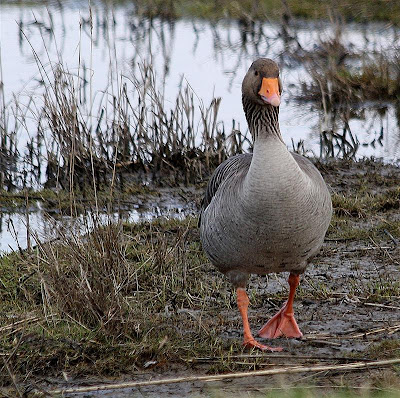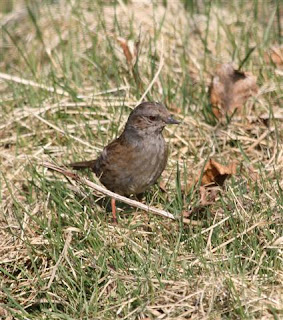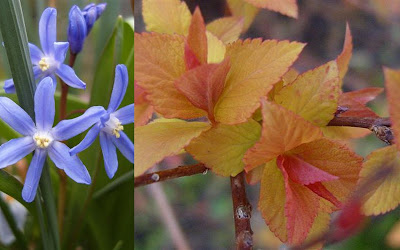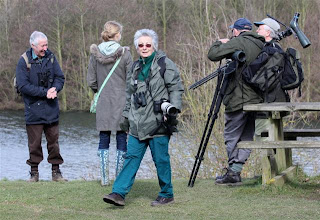.jpg)
Monday 30 March 2009
Saturday 28 March 2009
Garden in Late March
 You will no doubt recall an earlier post 'Garden Visitors Today' that included a picture of the Spring Snowflake (Leucojum vernum 'Carpathicum') that only grows 20cm high and has yellow nibs on the petals. During a recent visit by Johan (our Dutch friend & bulb expert) we discussed this plant as I could not recall seeing it in flower last spring. With the help of one of his bulb books we identified this individual as Leucojum vernum 'Podpolozje' which was supplied by bulb expert Janis Ruksans from Latvia two years ago. Johan told me that it was not unusual for this bulb to take one or even two years to produce flowers, so I consider myself very fortunate - I just hope it reappears next year. The right-hand picture below is L. aestivum that has green nibs on the petals.
You will no doubt recall an earlier post 'Garden Visitors Today' that included a picture of the Spring Snowflake (Leucojum vernum 'Carpathicum') that only grows 20cm high and has yellow nibs on the petals. During a recent visit by Johan (our Dutch friend & bulb expert) we discussed this plant as I could not recall seeing it in flower last spring. With the help of one of his bulb books we identified this individual as Leucojum vernum 'Podpolozje' which was supplied by bulb expert Janis Ruksans from Latvia two years ago. Johan told me that it was not unusual for this bulb to take one or even two years to produce flowers, so I consider myself very fortunate - I just hope it reappears next year. The right-hand picture below is L. aestivum that has green nibs on the petals.
I have never been very successful in growing the taller garden Tulips on our heavy clay as the bulbs often rot off through our wet winters but the smaller, early flowering botanical types (specie hybrids) seem to cope much better and are now beginning to bulk up.
Thursday 26 March 2009
Skywatch Friday - Sunset in Morocco

Tuesday 24 March 2009
FAB The Earlybirder reaches 21 again!
You will probably have noted that my postings have recently reduced to one or two a week and this is mainly due to work commitments. With hopefully a busy spring retail season ahead of us this trend of irregular posts is likely to continue for the time being but I hope you will all continue to drop by from time to time to see what I have been doing.
Some of you will no doubt have seen that I occasionally sign off comments on your blogs with ”FAB” and I promised one of my earliest followers that I would explain what this meant.
If you look up fab in Wiktionary, you might find answers such as:
F.A.B., a radio sign-off used in the Thunderbirds TV series;
From fabulous, by shortening;
Film Advisory Board;
FAB, the IATA airport code for Farnborough Airfield;
Well the answer is very simple. I was and always will be a fan of ‘Thunderbirds’, as when I sat glued to the TV screen I always felt a direct connection as my initials are, yes you may have guessed, F.A.B. During my previous career my initials on a document were a clear indication of my involvement and as a result I became known as and was called ‘FAB’ by my closest associates and friends rather than Frank.
Saturday 21 March 2009
1st day of spring and Buzzards
With the possibility of Garganey, Little Ringed Plover and hirrundines I visited Pulborough Brooks RSPB. When I checked in at the Info Centre the lady said “I presume you don’t need a map?” – How did she know I’ve been coming here for well over 15 years!
 Dunnock
DunnockBlackthorn blossom was everywhere, signifying the "start of spring".
Eurasian Wigeon
Long-tailed Tit
All in all, despite the lack of two of the 'target' species, not a bad day after all.
Friday 20 March 2009
Forgotten Photo - Kestrel

Wednesday 18 March 2009
Spring Colour on Battlestone Hill
Saturday 14 March 2009
Garden - Mid March


Friday 13 March 2009
Limited Birding this week!

Wednesday 11 March 2009
The Barn Owl by Ted Kooser
up under the starry nail-hole twinkle of the old tin roof,
there in a nest of straw and bailing twine I have hidden my valentine for you:
a white heart woven of snowy feathers in which wide eyes are welcome
open to you as you climb the rickety ladder to my love.
Behind those eyes lies a boudoir of intimate darkness, darling, the silks of oblivion.
And set like a jewel dead center in the heart is a golden hook the size of a finger ring,
to hold you always, plumpest sweetheart mouse of mine.
Tuesday 10 March 2009
Barn Owl (Tyto alba)
Sunday 8 March 2009
Bloggers visit Holmethorpe

Saturday 7 March 2009
Garden visitors today.
After a visit to the local re-cycling centre I heard two more sounds - Goldfinch and then Siskin (another garden first). Unfortunately he wouldn't show himself fully so only got a partial photo!
Other visitors were Blackbird, Starling, Collared Doves & the daily fly over of Rose-ringed Parakeets, Black-headed Gulls, Crow & Magpies.
Friday 6 March 2009
Wildlife at Whichford Pottery
While working in the office with Paula we saw a pair of Sparrowhawks & a Buzzard fly over.
While my colleagues were given a personalised tour of the pottery I spent time searching out some new designs. The centre picture shows the pots after the slip has been applied and drying out prior to firing in the kiln. The other shots show the final products as designed by one of the throwers.
Other new pots incorporate some wildlife - Bees on an Armscote Bee Pot & a Salamander on (yes you guessed correct) a Salamander Pot.
Breaking new boundaries Jim Keeling has designed and produced this Great Warwick Pot using a specially formulated black glaze to create this unique and innovative piece of work. It is a very, very expensive object (which I could easily hide inside) because all the embossed motifs have been painstakingly oil-gilded with several thickness 23.5 ct gold by a Master Gilder!












